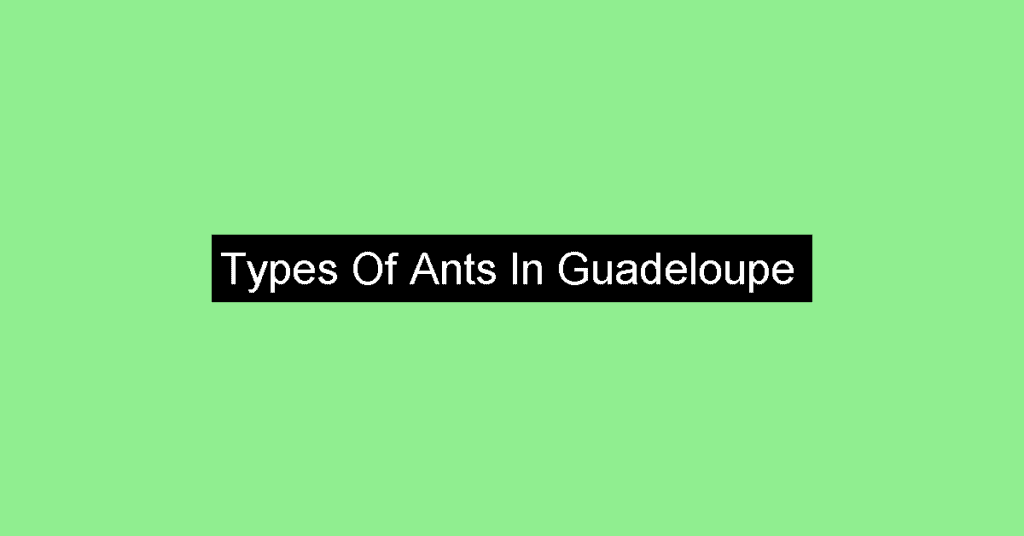Nestled in the Caribbean Sea lies the beautiful archipelago of Guadeloupe, a French overseas region located in the Lesser Antilles. With a tropical climate and lush vegetation, Guadeloupe boasts a diverse range of flora and fauna, including exotic birds, reptiles, and marine life.
The region’s warm and humid weather, with temperatures averaging around 80°F year-round, provides the perfect environment for the growth of tropical fruits and vegetables, such as bananas, pineapples, and mangoes. The crystal-clear waters surrounding Guadeloupe are home to a variety of marine species, including sea turtles, dolphins, and colorful fish.
With its stunning natural beauty and abundant wildlife, Guadeloupe is a true paradise for nature lovers and outdoor enthusiasts. .
Types Of Ants In Guadeloupe
The Types Of Ants In Guadeloupe are listed here: Trap-Jaw Ants, Carpenter And Sugar Ants, Acrobat Ants, Dolly Ants, Razorjaw Ants, Trailing Pharaoh And Timid Ants, Mite-Eating Ants, Crazy Ants, Trap-Jaw Ants, Crazy Ants, Platythyrea, Probolomyrmex, Pseudoponera, Ponerine Ants, Vampire Ants, Miniature Trap-Jaw Ants, Tapinoma, Thaumatomyrmex, Exotic Ants, Compact Carpenter Ants, Six-Spotted Carpenter Ants, Emerys Sneaking Ants, Sneaking Ants, Fungus-Growing Ants, Crypt Ants, Carribean Wingless Queen Ants, Flower Ants, Trap-Jaw Ants, Rapacious Panther Ants, Big Headed Ants, Big Headed Ants, Big Headed Ants, Common Silvery Hunter Ants, Dracula Ants, Pan-Tropical Panther Ants, Rogeria Foreli, Tropical Fire Ants, Fire Ants, Fire Ants, Miniature Trap-Jaw Ants, Miniature Trap-Jaw Ants, Miniature Trap-Jaw Ants, Miniature Trap-Jaw Ants, Rogers Dacetine Ants, Groove-Headed Fierce Ants, Singapore Ants, Little Fire Ants.
If you’ve found some other ants in this region, contact us, and we will add them to the list!
1) Trap-Jaw Ants, Anochetus
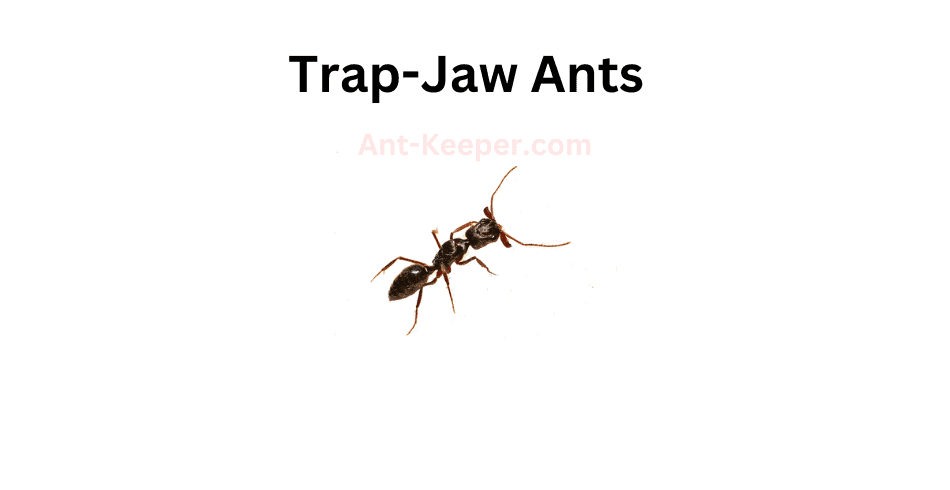
Trap-jaw ants are a species of ants that belong to the genus Odontomachus.
These ants are known for their unique and powerful mandibles, which they use to capture prey and defend their colonies.
The mandibles of trap-jaw ants are capable of closing at incredible speeds, reaching up to 140 miles per hour.
This allows them to snap their jaws shut with incredible force, which can stun or kill their prey.
Trap-jaw ants are found in a variety of habitats, including forests, grasslands, and deserts.
They are typically active during the day and are known to be highly territorial.
These ants are also known for their ability to jump, which they use to escape danger or to capture prey.
Trap-jaw ants are omnivorous, meaning that they eat both plant and animal matter.
They are known to feed on a variety of insects, including other ants, as well as nectar and other sweet substances.
These ants are also known to be scavengers, feeding on dead insects and other organic matter.
The colonies of trap-jaw ants are typically small, with only a few hundred individuals.
However, they are highly organized and have a strict social hierarchy.
The queen is the largest member of the colony and is responsible for laying eggs.
The workers, which are all female, are responsible for foraging, caring for the young, and defending the colony.
Overall, trap-jaw ants are fascinating creatures that have evolved unique adaptations to help them survive in their environments.
Their powerful mandibles and jumping abilities make them formidable predators, while their social organization allows them to work together to protect their colonies and ensure their survival.
2) Carpenter And Sugar Ants, Camponotus

Carpenter ants and sugar ants are two common species of ants found in many regions of the world.
Carpenter ants are known for their ability to excavate wood and create nests within it.
They are typically larger in size than sugar ants and have a black or dark brown coloration.
Carpenter ants are also known for their strong mandibles, which they use to chew through wood and other materials.
Sugar ants, on the other hand, are smaller in size and have a yellow or brown coloration.
They are named for their preference for sugary foods and are often found in kitchens and other areas where food is stored.
Sugar ants are also known for their ability to form large colonies, with thousands of individual ants working together to gather food and care for their young.
Both carpenter ants and sugar ants play important roles in their ecosystems.
Carpenter ants help to break down dead wood and other plant material, which helps to recycle nutrients back into the soil.
Sugar ants help to disperse seeds and pollinate plants, which helps to maintain healthy ecosystems.
However, both species can also be pests when they invade human homes and buildings.
Carpenter ants can cause damage to wooden structures, while sugar ants can contaminate food and be a nuisance to homeowners.
It is important to take steps to prevent ant infestations and to control them if they do occur, in order to protect both human health and the health of the environment.
3) Acrobat Ants, Crematogaster

Acrobat ants, also known as Crematogaster spp., are a genus of ants that are found in various parts of the world.
These ants are known for their unique ability to contort their bodies and move in acrobatic ways, hence their name.
Acrobat ants are relatively small, with workers measuring between 2-5mm in length.
They are typically brown or black in color, with a slender body and long legs.
These ants are known for their aggressive behavior and will readily defend their nests against intruders.
One of the most interesting features of acrobat ants is their ability to use their mandibles to grip onto surfaces and contort their bodies in unusual ways.
This allows them to move along narrow branches, twigs, and other surfaces that would be difficult for other ants to navigate.
They are also able to use this ability to escape from predators, such as birds and other insects.
Acrobat ants are omnivorous, meaning that they will eat both plant and animal matter.
They are known to feed on insects, nectar, and honeydew, as well as fruits and seeds.
These ants are also known to tend to aphids, protecting them from predators in exchange for the sweet honeydew that the aphids produce.
In terms of their social structure, acrobat ants are typically organized into colonies that are led by a queen.
The queen is responsible for laying eggs, while the workers are responsible for foraging, caring for the young, and defending the nest.
Overall, acrobat ants are fascinating creatures that have adapted unique abilities to survive in their environments.
Their acrobatic abilities and aggressive behavior make them a formidable force in the insect world.
4) Dolly Ants, Dolichoderus
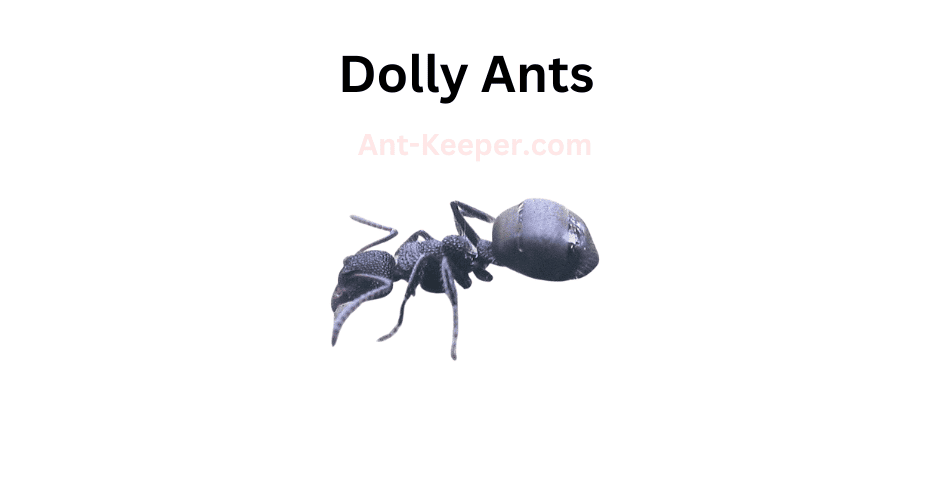
Dolly Ants, also known as Dolichoderus spp., are a species of ant that belong to the family Formicidae.
These ants are known for their distinctive elongated heads and bodies, which give them a unique appearance compared to other ant species.
Dolly Ants are typically found in forested areas, where they build their nests in soil or under rocks.
They are known to be highly social insects, living in large colonies that can contain thousands of individuals.
Within these colonies, there is a strict division of labor, with different ants taking on specific roles such as foraging, caring for the young, and defending the colony.
One interesting aspect of Dolly Ant behavior is their use of chemical communication.
These ants use pheromones to communicate with each other, leaving trails of scent that other ants can follow to locate food sources or to find their way back to the nest.
They also use pheromones to signal danger, which can trigger a coordinated response from the colony to defend against predators.
Dolly Ants are omnivorous, feeding on a variety of foods including insects, nectar, and plant sap.
They are also known to have a mutualistic relationship with certain plant species, where they protect the plants from herbivores in exchange for a source of food.
Overall, Dolly Ants are a fascinating species of ant with unique physical and behavioral characteristics.
Their social structure and use of chemical communication make them an important subject of study for researchers interested in understanding the behavior of social insects.
5) Razorjaw Ants, Leptogenys

The Razorjaw Ant, also known as the Pachycondyla villosa, is a species of ant belonging to the subfamily Ponerinae.
These ants are known for their sharp mandibles, which are used for hunting and defense.
The workers of this species are typically around 8-10mm in length, while the queen can reach up to 15mm.
Razorjaw Ants are found in a variety of habitats, including forests, grasslands, and deserts.
They are known to be aggressive predators, feeding on a variety of insects and other arthropods.
These ants are also known to scavenge for food, and will even attack and kill other ant species to steal their food.
The nests of Razorjaw Ants are typically found in soil or leaf litter, and can be quite large.
The queen is responsible for laying eggs, and the workers are responsible for caring for the brood and maintaining the nest.
These ants are also known for their ability to defend their nest, and will aggressively attack any intruders.
Overall, the Razorjaw Ant is a fascinating species of ant known for its sharp mandibles, aggressive behavior, and impressive hunting skills.
6) Trailing Pharaoh And Timid Ants, Monomorium

The Trailing Pharaoh ant, also known as the Monomorium pharaonis, is a small, reddish-brown ant species that is commonly found in urban areas.
These ants are known for their ability to form large colonies, which can consist of thousands of individuals.
One interesting behavior of the Trailing Pharaoh ant is their tendency to trail behind other ants.
This behavior is thought to be a form of communication, as the trailing ants are able to follow the scent trail left by the leading ants.
This behavior is also used to locate food sources, as the trailing ants are able to follow the trail to the source of the food.
In contrast to the bold behavior of the Trailing Pharaoh ant, the Timid ant, also known as the Temnothorax species, is a much more cautious species.
These ants are small and brown, and are often found in wooded areas.
They are known for their timid behavior, and will often retreat into their nests when threatened.
Despite their timid nature, the Timid ant is still able to form large colonies.
They are also known for their ability to adapt to changing environments, and can be found in a variety of habitats, including forests, meadows, and even urban areas.
Overall, both the Trailing Pharaoh ant and the Timid ant are fascinating species that demonstrate unique behaviors and adaptations.
By studying these ants, scientists can gain a better understanding of the complex social behaviors and ecological roles of ants in their respective environments.
7) Mite-Eating Ants, Myrmecina

The Mite-Eating Ant, also known as the Pheidole megacephala, is a species of ant that is commonly found in tropical and subtropical regions around the world.
These ants are known for their unique feeding habits, as they primarily feed on mites and other small arthropods.
The Mite-Eating Ant is a relatively small ant, with workers measuring between 2-3mm in length.
They have a distinctive head shape, with a large and elongated head that is almost as wide as their thorax.
Their bodies are typically a reddish-brown color, with darker legs and antennae.
These ants are highly social, living in large colonies that can contain thousands of individuals.
The colonies are typically divided into two groups: workers and reproductive individuals.
The workers are responsible for foraging for food, caring for the young, and defending the colony, while the reproductive individuals are responsible for producing offspring.
One of the most interesting aspects of the Mite-Eating Ant is their feeding habits.
These ants are specialized predators, feeding almost exclusively on mites and other small arthropods.
They use their large mandibles to capture and kill their prey, and then carry it back to the colony to be consumed.
In addition to their unique feeding habits, the Mite-Eating Ant is also known for its ability to adapt to a wide range of environments.
They are able to thrive in both natural and urban environments, and can be found in a variety of habitats, including forests, grasslands, and even in homes and buildings.
Overall, the Mite-Eating Ant is a fascinating species of ant that has adapted to a unique niche in the ecosystem.
Their specialized feeding habits and ability to thrive in a variety of environments make them an important species to study and understand.
8) Crazy Ants, Nylanderia
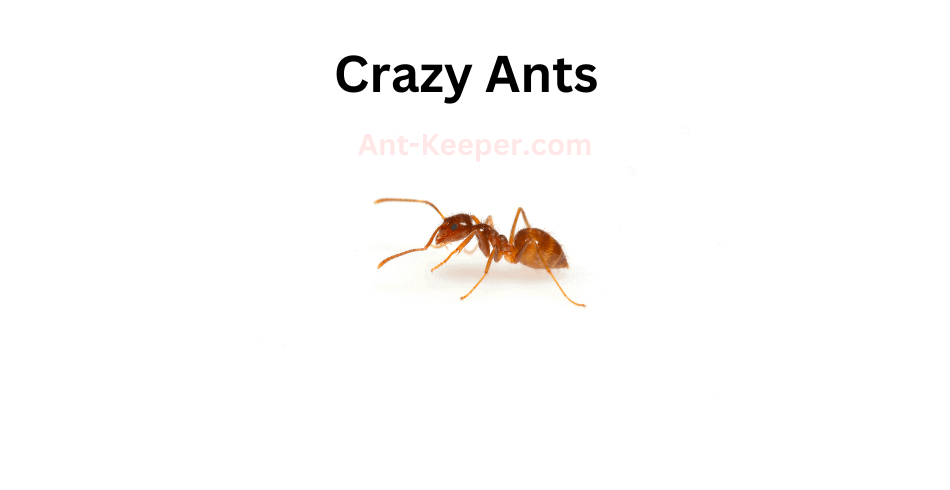
Crazy ants, also known as Nylanderia fulva, are a species of ant that belong to the family Formicidae.
They are small in size, measuring only about 2.2 to 3 mm in length, and are reddish-brown in color.
These ants are known for their erratic and unpredictable behavior, hence the name "crazy ants."
Crazy ants are native to South America, but have since spread to other parts of the world, including North America, Asia, and Australia.
They are highly adaptable and can thrive in a variety of environments, including urban areas, forests, and grasslands.
One of the most notable characteristics of crazy ants is their ability to form large colonies with multiple queens.
This allows them to quickly establish themselves in new areas and outcompete other ant species.
Crazy ants are also known for their aggressive behavior towards other insects and animals, including humans.
In addition to their aggressive behavior, crazy ants are also known for their ability to cause damage to electrical equipment.
They are attracted to electrical currents and can easily short-circuit electronics, causing damage and potentially starting fires.
Despite their small size, crazy ants are a formidable species that can have a significant impact on their environment.
As they continue to spread to new areas, it is important to monitor their behavior and take steps to control their populations in order to minimize their impact on ecosystems and human infrastructure.
9) Trap-Jaw Ants, Odontomachus

Trap-jaw ants are a species of ants that belong to the genus Odontomachus.
These ants are known for their unique and powerful mandibles, which they use to capture prey and defend their colonies.
The mandibles of trap-jaw ants are capable of closing at incredible speeds, reaching up to 140 miles per hour.
This allows them to snap their jaws shut with incredible force, which can stun or kill their prey.
Trap-jaw ants are found in a variety of habitats, including forests, grasslands, and deserts.
They are typically active during the day and are known to be highly territorial.
These ants are also known for their ability to jump, which they use to escape danger or to capture prey.
Trap-jaw ants are omnivorous, meaning that they eat both plant and animal matter.
They are known to feed on a variety of insects, including other ants, as well as nectar and other sweet substances.
These ants are also known to be scavengers, feeding on dead insects and other organic matter.
The colonies of trap-jaw ants are typically small, with only a few hundred individuals.
However, they are highly organized and have a strict social hierarchy.
The queen is the largest member of the colony and is responsible for laying eggs.
The workers, which are all female, are responsible for foraging, caring for the young, and defending the colony.
Overall, trap-jaw ants are fascinating creatures that have evolved unique adaptations to help them survive in their environments.
Their powerful mandibles and jumping abilities make them formidable predators, while their social organization allows them to work together to protect their colonies and ensure their survival.
10) Crazy Ants, Paratrechina

Crazy ants, also known as Nylanderia fulva, are a species of ant that belong to the family Formicidae.
They are small in size, measuring only about 2.2 to 3 mm in length, and are reddish-brown in color.
These ants are known for their erratic and unpredictable behavior, hence the name "crazy ants."
Crazy ants are native to South America, but have since spread to other parts of the world, including North America, Asia, and Australia.
They are highly adaptable and can thrive in a variety of environments, including urban areas, forests, and grasslands.
One of the most notable characteristics of crazy ants is their ability to form large colonies with multiple queens.
This allows them to quickly establish themselves in new areas and outcompete other ant species.
Crazy ants are also known for their aggressive behavior towards other insects and animals, including humans.
In addition to their aggressive behavior, crazy ants are also known for their ability to cause damage to electrical equipment.
They are attracted to electrical currents and can easily short-circuit electronics, causing damage and potentially starting fires.
Despite their small size, crazy ants are a formidable species that can have a significant impact on their environment.
As they continue to spread to new areas, it is important to monitor their behavior and take steps to control their populations in order to minimize their impact on ecosystems and human infrastructure.
11) Platythyrea

Platythyreabe is a species of ant that belongs to the family Formicidae.
These ants are known for their unique physical characteristics, including their flattened bodies and elongated mandibles.
Platythyreabe ants are typically found in forested areas and are known to be active foragers, often hunting for small insects and other invertebrates.
One of the most interesting aspects of Platythyreabe ants is their social behavior.
These ants live in colonies that are typically composed of several hundred individuals.
Within these colonies, there is a strict hierarchy, with a single queen ant at the top.
The queen is responsible for laying eggs, while the other ants in the colony are responsible for caring for the young and maintaining the nest.
Platythyreabe ants are also known for their aggressive behavior.
When threatened, these ants will use their elongated mandibles to defend themselves and their colony.
They are also known to release a chemical signal that alerts other ants in the colony to the presence of a threat.
Despite their aggressive behavior, Platythyreabe ants play an important role in their ecosystem.
They help to control populations of small insects and other invertebrates, and they also serve as a food source for larger predators.
Overall, Platythyreabe ants are fascinating creatures that offer a unique glimpse into the complex world of social insects.
12) Probolomyrmex
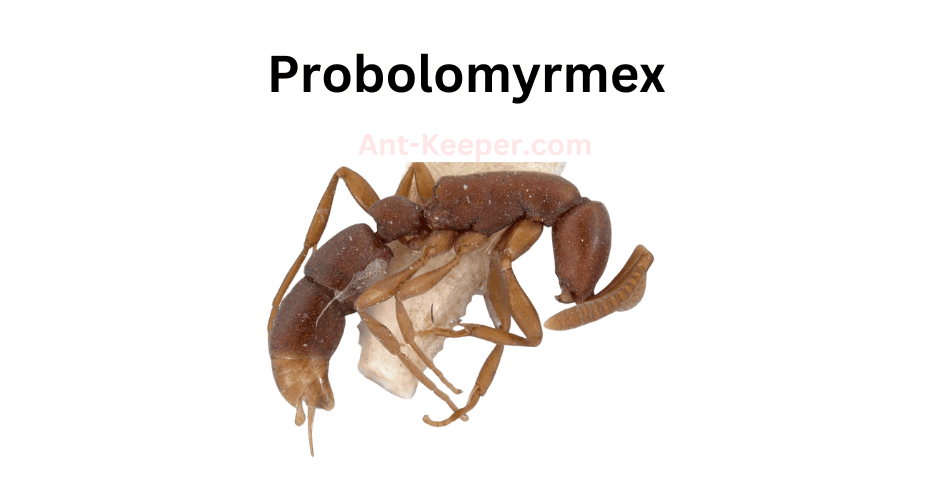
Probolomyrmex is a genus of ants that belongs to the subfamily Proceratiinae.
These ants are known for their unique morphology, which includes a long and slender body, a narrow head, and elongated mandibles.
The genus is characterized by the presence of a distinct petiole, which separates the thorax and the abdomen.
Probolomyrmex ants are typically found in tropical and subtropical regions, where they inhabit a variety of habitats, including forests, grasslands, and deserts.
They are known to be highly aggressive and territorial, often engaging in fierce battles with other ant species.
One of the most interesting aspects of Probolomyrmex ants is their social behavior.
These ants are known to be highly organized, with a well-defined caste system that includes workers, soldiers, and reproductive individuals.
The workers are responsible for foraging, nest maintenance, and caring for the young, while the soldiers defend the colony against predators and other threats.
Despite their small size, Probolomyrmex ants play an important role in their ecosystem.
They are known to be efficient predators, feeding on a variety of insects and other small invertebrates.
They also help to aerate the soil and distribute nutrients, which can have a positive impact on plant growth.
Overall, Probolomyrmex ants are a fascinating and important group of insects that are worthy of further study and conservation efforts.
13) Pseudoponera
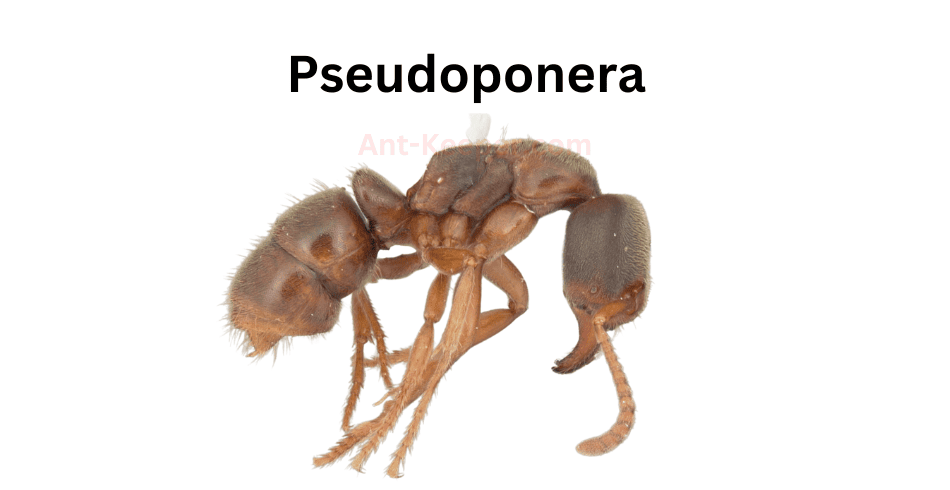
Pseudoponerabe is a species of ant that belongs to the family Formicidae.
These ants are known for their unique physical characteristics and behavior.
They are small in size, measuring only a few millimeters in length, and have a dark brown or black coloration.
One of the most distinctive features of Pseudoponerabe ants is their elongated mandibles.
These mandibles are used for a variety of tasks, including hunting, defense, and nest building.
The ants are also known for their aggressive behavior, and will not hesitate to attack other insects or animals that they perceive as a threat.
Pseudoponerabe ants are typically found in forested areas, where they build their nests in the soil or in decaying wood.
They are omnivorous, feeding on a variety of insects, fruits, and seeds.
The ants are also known to engage in trophallaxis, a behavior in which they exchange food with other members of their colony.
Like many other ant species, Pseudoponerabe ants have a complex social structure.
They live in colonies that can contain thousands of individuals, with each ant having a specific role to play in the colony's survival.
The queen ant is responsible for laying eggs, while the worker ants are responsible for foraging, nest building, and caring for the young.
Overall, Pseudoponerabe ants are fascinating creatures that play an important role in their ecosystem.
Their unique physical characteristics and behavior make them a fascinating subject for study, and their presence in forested areas helps to maintain the delicate balance of nature.
14) Ponerine Ants, Pseudoponera

Ponerine ants are a diverse group of ants belonging to the subfamily Ponerinae.
They are found in various habitats, including forests, grasslands, and deserts, and are known for their aggressive behavior and powerful stings.
Ponerine ants are typically medium to large in size, with workers ranging from 3 to 15 millimeters in length.
They have a distinctive appearance, with elongated bodies and long, curved mandibles that they use to capture prey and defend their colonies.
These ants are solitary hunters, and their diet consists mainly of other insects, spiders, and small invertebrates.
They are also known to scavenge on carrion and plant nectar.
Ponerine ants are highly territorial and will aggressively defend their nests against intruders.
They are known for their painful stings, which can cause swelling and discomfort in humans.
Despite their aggressive behavior, ponerine ants play an important role in their ecosystems.
They help to control populations of other insects and contribute to soil health through their nest-building activities.
Overall, ponerine ants are a fascinating and important group of ants that play a vital role in many ecosystems around the world.
15) Vampire Ants, Stigmatomma
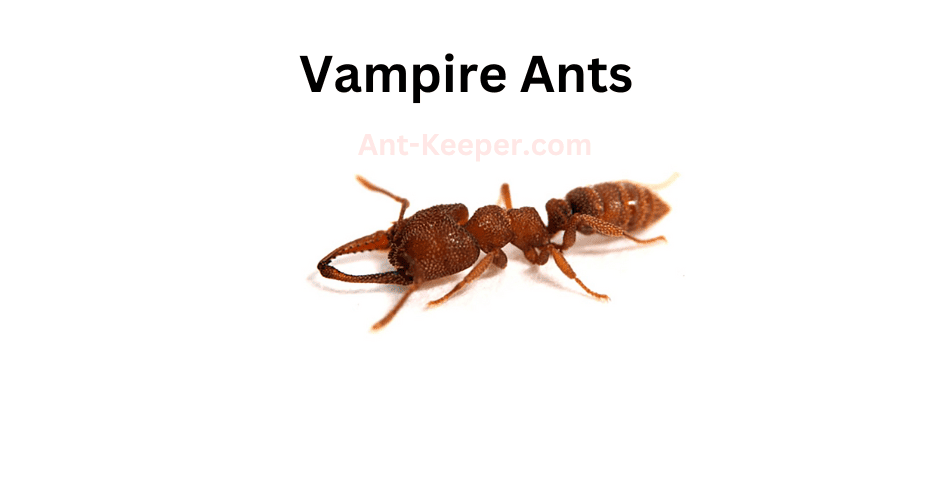
Vampire ants, also known as blood-sucking ants, are a species of ants that feed on the blood of other insects.
These ants are known for their unique feeding behavior, which involves biting into the exoskeleton of their prey and then sucking out their blood.
Vampire ants are typically found in tropical and subtropical regions, where they live in colonies of up to several thousand individuals.
They are known for their aggressive behavior and will attack other insects, including larger prey such as grasshoppers and caterpillars.
One of the most interesting aspects of vampire ants is their ability to adapt to their environment.
In some cases, these ants have been known to feed on the blood of their own colony members when other sources of food are scarce.
Vampire ants are also known for their unique physical characteristics.
They have long, curved mandibles that are used to bite into the exoskeleton of their prey.
They also have specialized mouthparts that allow them to suck out the blood of their victims.
Despite their aggressive behavior and blood-sucking tendencies, vampire ants play an important role in their ecosystem.
They help to control the populations of other insects and contribute to the overall balance of their environment.
Overall, vampire ants are a fascinating species of ants that have adapted to their environment in unique and interesting ways.
Their behavior and physical characteristics make them a subject of interest for scientists and nature enthusiasts alike.
16) Miniature Trap-Jaw Ants, Strumigenys
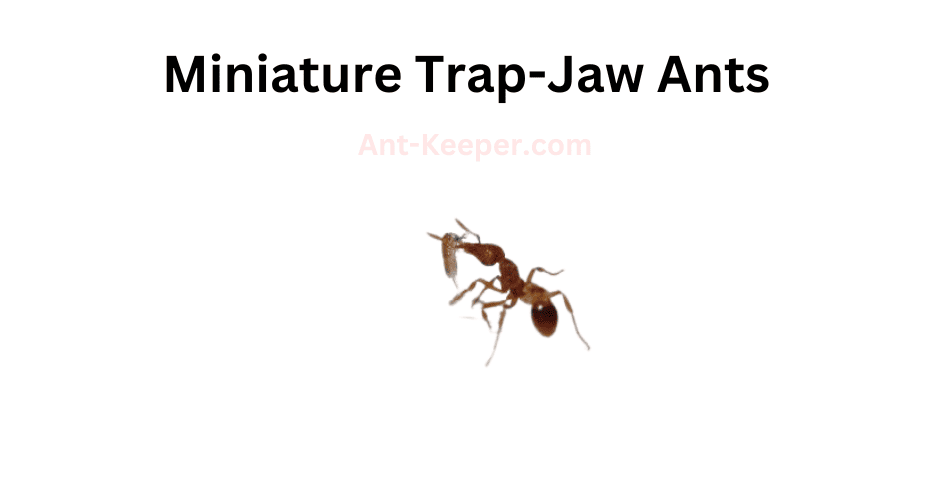
The Miniature Trap-Jaw Ants, scientifically known as Odontomachus sp., are a species of ants that belong to the family Formicidae.
These ants are known for their unique and powerful mandibles, which they use to capture prey and defend their colonies.
The Miniature Trap-Jaw Ants are relatively small in size, measuring only a few millimeters in length.
They have a dark brown or black coloration and a slender body shape.
Their most distinctive feature is their mandibles, which are elongated and can snap shut with incredible force.
These mandibles are used to capture prey, crush seeds, and defend the colony against predators.
The Miniature Trap-Jaw Ants are found in a variety of habitats, including forests, grasslands, and deserts.
They are known to be active during the day and are often seen foraging for food.
These ants are omnivorous and feed on a variety of food sources, including insects, nectar, and seeds.
The Miniature Trap-Jaw Ants are social insects and live in colonies that can range in size from a few dozen to several thousand individuals.
The colony is typically led by a queen, who is responsible for laying eggs and maintaining the colony's population.
The workers are responsible for foraging, caring for the young, and defending the colony.
Overall, the Miniature Trap-Jaw Ants are fascinating insects that have evolved unique adaptations to survive in their environment.
Their powerful mandibles and social behavior make them an important part of many ecosystems.
17) Tapinoma
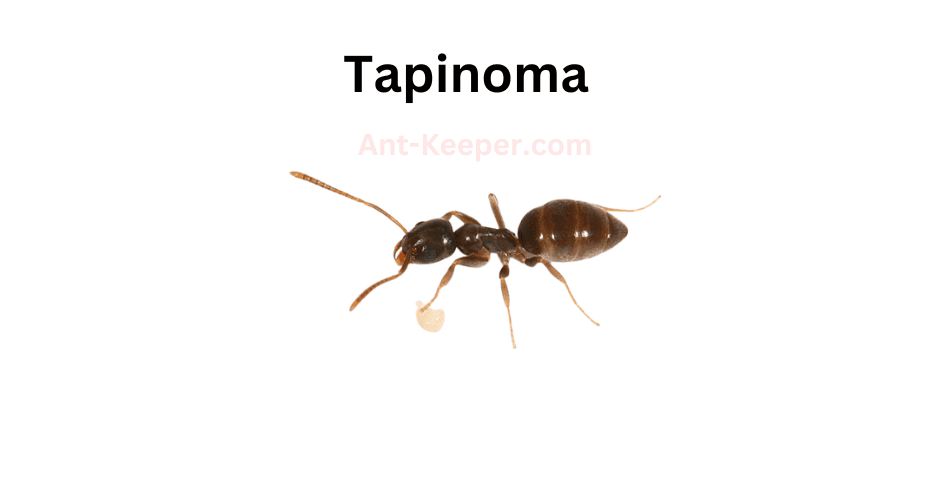
Tapinoma is a genus of ants that belongs to the family Formicidae.
The species Tapinoma is a small ant that measures about 2-3 mm in length.
They are commonly found in urban and suburban areas, and are known to invade homes and buildings in search of food and shelter.
Tapinoma ants are light brown in color and have a slender body with long legs.
They have a distinctively shaped head that is wider than their thorax, and they possess a pair of antennae that are bent at a right angle.
These ants are known for their ability to form large colonies, which can consist of thousands of individuals.
Tapinoma ants are omnivorous and feed on a variety of food sources, including insects, nectar, and honeydew.
They are also known to scavenge for food in garbage cans and other waste areas.
These ants are attracted to sweet and sugary substances, and will often invade kitchens and pantries in search of food.
Tapinoma ants are not known to be aggressive towards humans, but they can become a nuisance when they invade homes and buildings.
They are known to build their nests in wall voids, under floors, and in other hidden areas.
If left unchecked, these ants can cause damage to structures and can contaminate food sources.
Overall, Tapinoma ants are a common pest in many parts of the world.
While they are not harmful to humans, they can be a nuisance when they invade homes and buildings.
Proper pest control measures can help to prevent infestations and keep these ants at bay.
18) Thaumatomyrmex
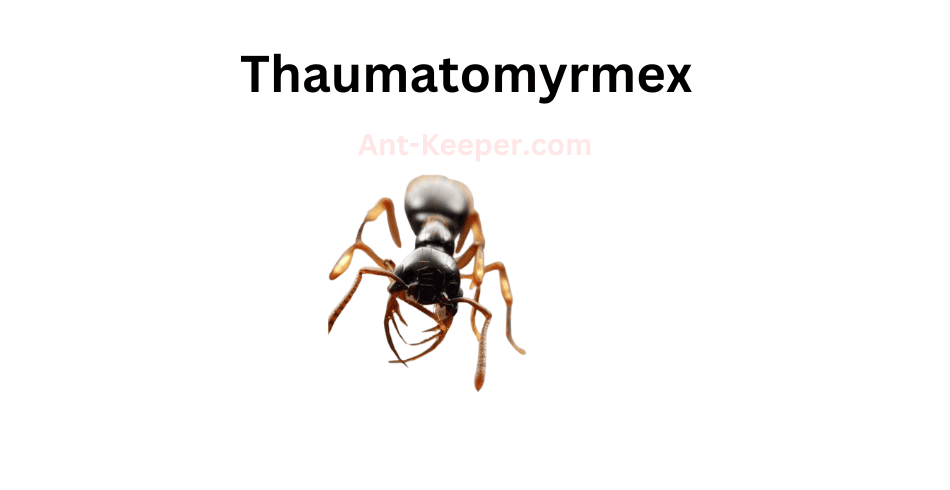
Thaumatomyrmex is a genus of ants that belongs to the subfamily Ponerinae.
The ants in this genus are known for their unique morphology and behavior.
Thaumatomyrmex ants are small in size, measuring between 2-5 mm in length.
They have a distinctive head shape, with a narrow and elongated mandible that is used for capturing prey.
Thaumatomyrmex ants are also known for their aggressive behavior.
They are solitary hunters and do not form large colonies like other ant species.
Instead, they hunt individually or in small groups.
Thaumatomyrmex ants are known to attack and kill other ant species, including those that are much larger than themselves.
The diet of Thaumatomyrmex ants consists mainly of other insects, such as termites and other ants.
They are also known to feed on nectar and honeydew produced by aphids and other plant-sucking insects.
Thaumatomyrmex ants are found in a variety of habitats, including forests, grasslands, and deserts.
They are most commonly found in tropical and subtropical regions.
Overall, Thaumatomyrmex ants are fascinating creatures with unique morphology and behavior.
Their aggressive hunting behavior and solitary lifestyle make them stand out among other ant species.
19) Exotic Ants, Anochetus Mayri
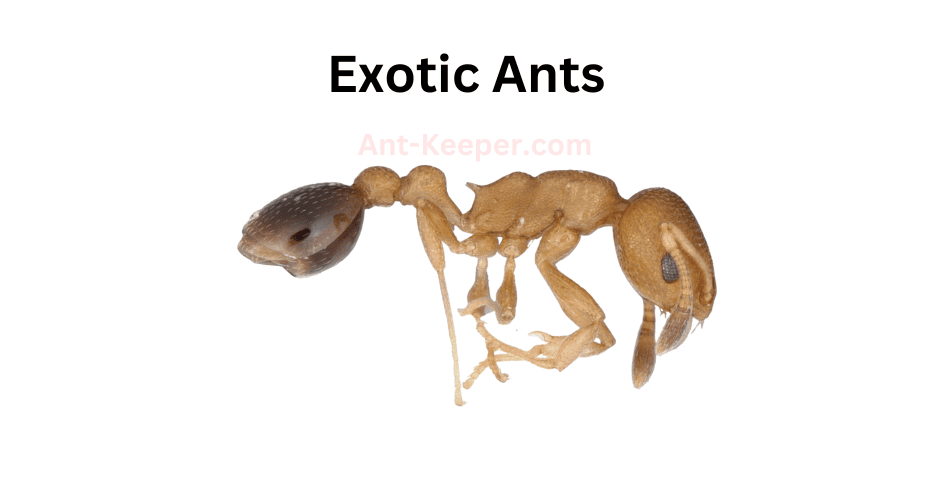
The Exotic Ants are a species of ants that are known for their unique physical characteristics and behavior.
These ants are relatively small in size, measuring between 2 to 5 millimeters in length.
They have a distinct coloration, with their bodies ranging from light brown to dark black.
The Exotic Ants are also known for their aggressive behavior, often attacking other insects and even humans if they feel threatened.
One of the most interesting features of the Exotic Ants is their ability to form large colonies.
These colonies can consist of thousands of ants, with each ant having a specific role to play in the colony's survival.
The Exotic Ants are also known for their ability to adapt to different environments, making them a successful species in many parts of the world.
The Exotic Ants are omnivorous, meaning that they feed on both plant and animal matter.
They are known to consume a variety of foods, including insects, fruits, and seeds.
The Exotic Ants are also known for their ability to farm aphids, which they use for their honeydew secretion.
In terms of reproduction, the Exotic Ants have a unique system where the queen ant is responsible for laying eggs, while the worker ants take care of the young.
The queen ant can lay up to 1,000 eggs in a single day, ensuring the survival of the colony.
Overall, the Exotic Ants are a fascinating species of ants that have adapted to different environments and have a unique social structure.
Their aggressive behavior and ability to form large colonies make them a successful species in many parts of the world.
20) Compact Carpenter Ants, Camponotus Planatus
The Compact Carpenter Ant, also known as Camponotus planatus, is a species of ant that belongs to the family Formicidae.
These ants are typically small in size, measuring between 4 to 6 millimeters in length.
They have a black or dark brown body with a shiny appearance.
Compact Carpenter Ants are known for their ability to build nests in small spaces, such as cracks in walls or between rocks.
They are also known to build nests in dead wood, which they excavate to create galleries and chambers for their colony.
These ants are omnivorous, meaning they consume both plant and animal matter.
They primarily feed on honeydew, nectar, and insects.
They are also known to scavenge for food, and will consume dead insects and other small animals.
Compact Carpenter Ants are social insects, living in colonies that can range in size from a few dozen to several thousand individuals.
The colony is typically led by a queen, who is responsible for laying eggs and producing new members of the colony.
The workers, which make up the majority of the colony, are responsible for foraging for food, caring for the young, and maintaining the nest.
Overall, the Compact Carpenter Ant is a fascinating species of ant that is well adapted to living in small spaces and scavenging for food.
Their ability to excavate wood and build nests in tight spaces makes them an important part of many ecosystems.
21) Six-Spotted Carpenter Ants, Camponotus Sexguttatus
The Six-Spotted Carpenter Ant (Camponotus sexguttatus) is a species of ant belonging to the genus Camponotus.
These ants are commonly found in wooded areas and are known for their ability to excavate wood to create their nests.
They are typically black in color and have six white spots on their abdomen, which is how they get their name.
The Six-Spotted Carpenter Ant is a relatively large ant, with workers ranging from 6 to 12 mm in length.
They are polymorphic, meaning that they have different sizes of workers within their colony.
The larger workers are responsible for excavating the wood and caring for the young, while the smaller workers are responsible for foraging for food.
These ants are omnivorous, meaning that they eat both plant and animal matter.
They have been known to feed on honeydew, nectar, and other sugary substances, as well as insects and other small animals.
The Six-Spotted Carpenter Ant is a social insect, living in colonies that can contain thousands of individuals.
They communicate with each other using chemical signals called pheromones, which help them to coordinate their activities and find food sources.
While the Six-Spotted Carpenter Ant is not considered a major pest, they can cause damage to wooden structures if their nests are located inside.
They are also known to bite if they feel threatened, although their bites are not typically harmful to humans.
Overall, the Six-Spotted Carpenter Ant is an interesting and important species of ant, playing a vital role in their ecosystem and providing valuable insights into the behavior of social insects.
22) Emerys Sneaking Ants, Cardiocondyla Emeryi
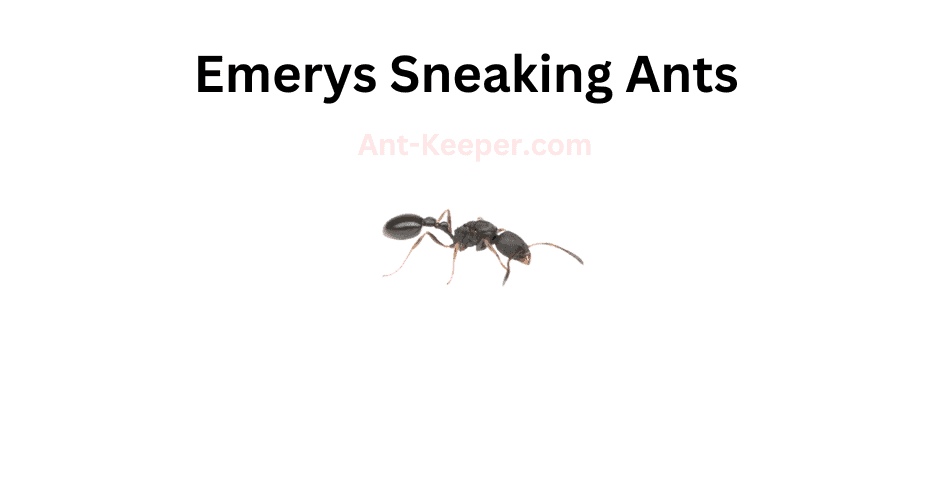
Emery's Sneaking Ants, also known as Pheidole emeryi, are a species of ant that belong to the family Formicidae.
These ants are known for their ability to sneak into other ant colonies and steal their resources without being detected.
Emery's Sneaking Ants are small in size, measuring only 2-3 mm in length.
They have a dark brown or black coloration and a distinctively large head in proportion to their body.
Their mandibles are also relatively large, which allows them to carry larger food items back to their own colony.
These ants are primarily found in forested areas and are known to be opportunistic feeders.
They will consume a variety of food sources, including other insects, nectar, and honeydew.
However, they are also known to steal food from other ant colonies, which is where they get their name.
Emery's Sneaking Ants have a unique strategy for infiltrating other ant colonies.
They will send out scouts to locate a nearby colony and then send in a small group of worker ants to steal food.
These worker ants will use their small size and agility to sneak past the guards of the other colony and steal food without being detected.
Despite their sneaky behavior, Emery's Sneaking Ants are not considered harmful to other ant colonies.
They do not engage in aggressive behavior and are not known to cause any significant damage to other ant colonies.
However, they are still an interesting species to study and observe in their natural habitat.
23) Sneaking Ants, Cardiocondyla Obscurior
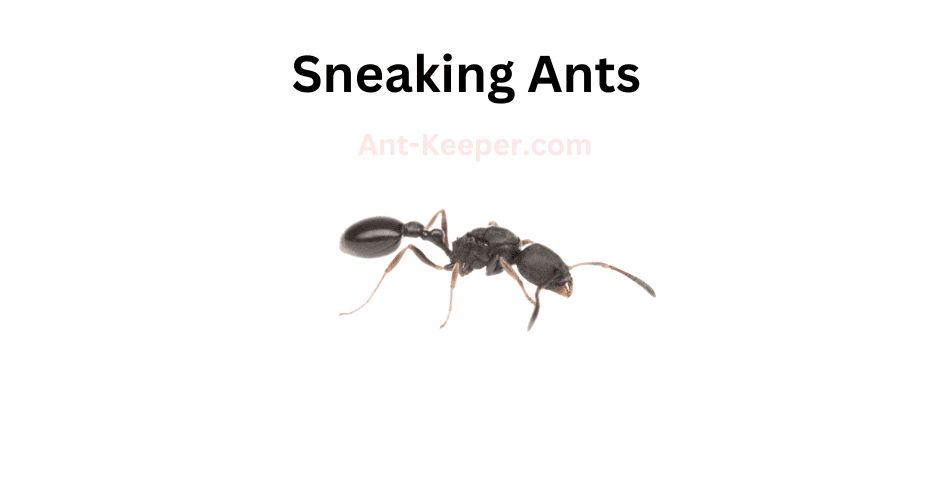
Sneaking Ants, also known as Camponotus obscuripes, are a species of ant that are commonly found in forested areas.
These ants are known for their ability to move quietly and quickly, making them difficult to detect.
Sneaking Ants are typically black or dark brown in color and range in size from 5 to 12 millimeters in length.
They have a distinctive, flattened head and a narrow waist, which helps them to navigate through tight spaces.
One of the most interesting aspects of Sneaking Ants is their behavior.
These ants are known for their ability to sneak up on other insects and steal their food.
They are also known to raid the nests of other ant species, taking their eggs and larvae back to their own colony to raise as their own.
Sneaking Ants are omnivorous, meaning they eat both plant and animal matter.
They have been observed feeding on nectar, honeydew, and small insects.
They are also known to scavenge for food, often taking advantage of the leftovers from other insects.
In terms of reproduction, Sneaking Ants have a unique system.
The colony is typically led by a single queen, who is responsible for laying eggs.
However, there are also a number of worker ants who are capable of laying eggs as well.
These eggs are typically unfertilized and produce male ants, which are used for mating purposes.
Overall, Sneaking Ants are a fascinating species with unique behaviors and adaptations.
Their ability to move quietly and quickly makes them a formidable predator, and their omnivorous diet allows them to thrive in a variety of environments.
24) Fungus-Growing Ants, Cyphomyrmex Minutus
Fungus-growing ants, also known as attine ants, are a group of ants that cultivate fungi as their primary food source.
These ants are found in various habitats, including tropical rainforests, savannas, and deserts.
Fungus-growing ants have a complex social structure, with a queen and several castes of workers.
The queen is responsible for laying eggs, while the workers are responsible for foraging, tending to the fungus gardens, and defending the colony.
The fungus gardens are the heart of the colony, and the ants take great care to maintain them.
The ants cultivate a specific species of fungus, which they feed with freshly cut leaves.
The fungus breaks down the leaves and converts them into a nutrient-rich substrate that the ants can consume.
Fungus-growing ants have evolved a mutualistic relationship with the fungus they cultivate.
The ants provide the fungus with a constant supply of food and a suitable environment for growth, while the fungus provides the ants with a nutritious food source.
However, the relationship between the ants and the fungus is not always harmonious.
The fungus is susceptible to infection by parasitic fungi, which can devastate the colony.
To prevent this, the ants have evolved a sophisticated system of hygiene, which includes removing infected fungus and burying it outside the colony.
Fungus-growing ants are an important part of many ecosystems, as they help to break down plant material and recycle nutrients.
They also provide a food source for other animals, such as birds and mammals.
However, some species of fungus-growing ants are considered pests, as they can cause damage to crops and other vegetation.
25) Crypt Ants, Hypoponera Opacior
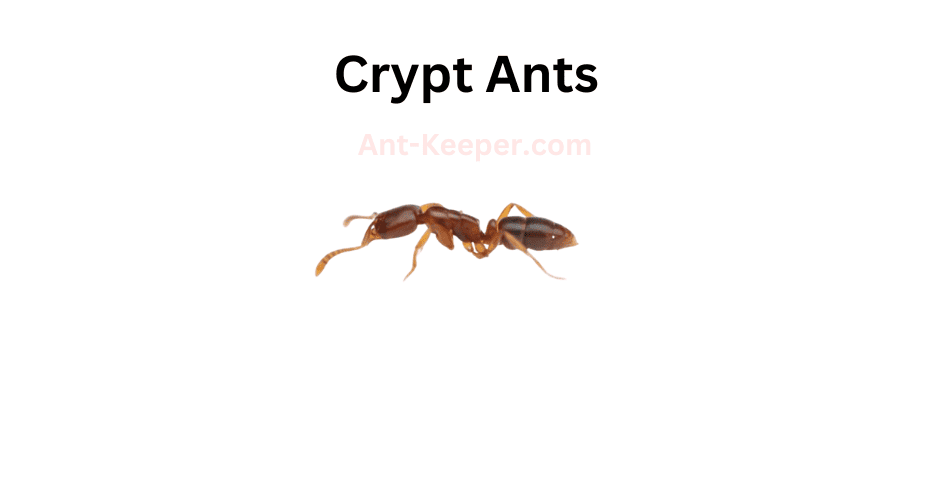
Crypt ants, also known as fungus-growing ants, are a group of ants that cultivate fungi for food.
They are found in various habitats, including forests, grasslands, and deserts.
Crypt ants are known for their unique nesting behavior, as they construct underground chambers to house their fungal gardens.
These ants have a symbiotic relationship with the fungi they cultivate.
The ants provide the fungi with a suitable environment for growth, while the fungi provide the ants with a source of food.
The ants also protect their fungal gardens from other insects and parasites.
Crypt ants are social insects, living in colonies that can range from a few dozen to several thousand individuals.
The colonies are organized into castes, with the queen being the largest and most important member.
The queen is responsible for laying eggs, while the workers are responsible for tending to the fungal gardens and caring for the young.
One interesting aspect of crypt ants is their ability to create "satellite" nests.
These nests are smaller chambers located near the main nest, and they serve as storage areas for food and as a place for the queen to lay eggs.
The satellite nests are connected to the main nest by underground tunnels, allowing the ants to move between them.
Overall, crypt ants are fascinating insects that have developed a unique way of obtaining food.
Their symbiotic relationship with fungi and their complex nesting behavior make them an important species to study in the field of entomology.
26) Carribean Wingless Queen Ants, Monomorium Ebeninum
The Caribbean Wingless Queen Ants, also known as Brachymyrmex spp., are a species of ant that belong to the family Formicidae.
These ants are characterized by their small size and lack of wings, which distinguishes them from other ant species.
The Caribbean Wingless Queen Ants are typically found in tropical and subtropical regions, where they inhabit a variety of habitats including forests, grasslands, and urban areas.
The Caribbean Wingless Queen Ants are social insects that live in colonies, which are typically composed of a single queen and several hundred workers.
The queen is responsible for laying eggs, while the workers are responsible for foraging, caring for the young, and defending the colony.
The Caribbean Wingless Queen Ants are known for their aggressive behavior, and will readily attack other ant species that invade their territory.
The Caribbean Wingless Queen Ants are omnivorous, and will feed on a variety of food sources including insects, nectar, and plant sap.
They are also known to cultivate and protect aphids, which provide them with a source of honeydew.
The Caribbean Wingless Queen Ants are important members of their ecosystems, as they help to control insect populations and contribute to soil health through their tunneling activities.
In conclusion, the Caribbean Wingless Queen Ants are a fascinating species of ant that play an important role in their ecosystems.
Their small size and lack of wings make them unique among ant species, and their aggressive behavior and omnivorous diet make them formidable predators.
Despite their small size, the Caribbean Wingless Queen Ants are an important part of the natural world, and their presence is essential for maintaining healthy ecosystems.
27) Flower Ants, Monomorium Floricola
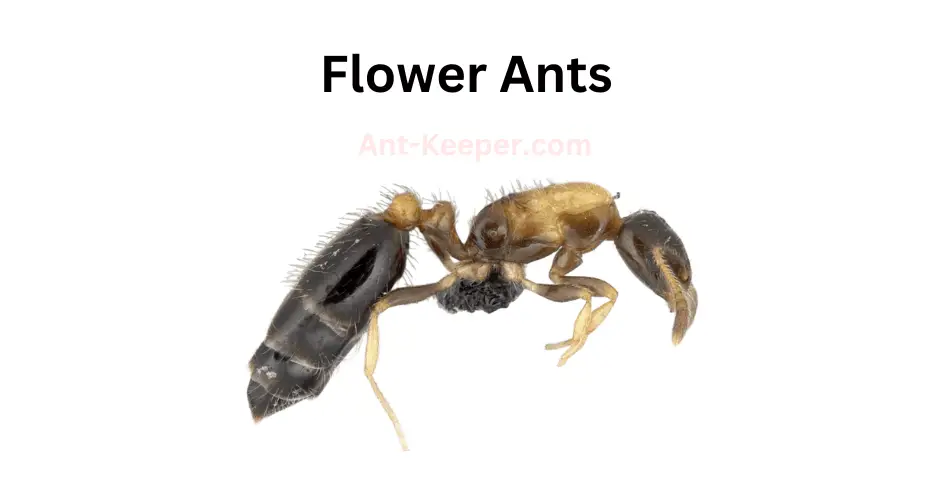
The Flower Ant, also known as the Camponotus consobrinus, is a species of ant that belongs to the Camponotus genus.
These ants are commonly found in various habitats, including forests, grasslands, and gardens.
They are known for their unique behavior of collecting nectar and pollen from flowers, hence their name.
The Flower Ants are relatively large, with workers measuring up to 12mm in length.
They have a black or dark brown body with reddish-brown legs and antennae.
The queen ants are even larger, measuring up to 18mm in length.
These ants are known for their strong mandibles, which they use to cut through plant material and defend their colony.
The Flower Ants are social insects that live in colonies consisting of a queen, workers, and males.
The queen is responsible for laying eggs, while the workers take care of the young and forage for food.
The males are responsible for mating with the queen.
One of the unique characteristics of the Flower Ants is their relationship with plants.
They are known to collect nectar and pollen from flowers, which they use as a source of food.
In return, they help pollinate the flowers, which is essential for the plants' reproduction.
The Flower Ants are also known for their aggressive behavior towards other ant species.
They will defend their territory and resources fiercely, often engaging in battles with other ant colonies.
In conclusion, the Flower Ants are a fascinating species of ant that have a unique relationship with plants.
They play an important role in pollination and are essential for the ecosystem.
Their aggressive behavior towards other ant species also highlights their importance in maintaining the balance of the ecosystem.
28) Trap-Jaw Ants, Odontomachus Ruginodis

Trap-jaw ants are a species of ants that belong to the genus Odontomachus.
These ants are known for their unique and powerful mandibles, which they use to capture prey and defend their colonies.
The mandibles of trap-jaw ants are capable of closing at incredible speeds, reaching up to 140 miles per hour.
This allows them to snap their jaws shut with incredible force, which can stun or kill their prey.
Trap-jaw ants are found in a variety of habitats, including forests, grasslands, and deserts.
They are typically active during the day and are known to be highly territorial.
These ants are also known for their ability to jump, which they use to escape danger or to capture prey.
Trap-jaw ants are omnivorous, meaning that they eat both plant and animal matter.
They are known to feed on a variety of insects, including other ants, as well as nectar and other sweet substances.
These ants are also known to be scavengers, feeding on dead insects and other organic matter.
The colonies of trap-jaw ants are typically small, with only a few hundred individuals.
However, they are highly organized and have a strict social hierarchy.
The queen is the largest member of the colony and is responsible for laying eggs.
The workers, which are all female, are responsible for foraging, caring for the young, and defending the colony.
Overall, trap-jaw ants are fascinating creatures that have evolved unique adaptations to help them survive in their environments.
Their powerful mandibles and jumping abilities make them formidable predators, while their social organization allows them to work together to protect their colonies and ensure their survival.
29) Rapacious Panther Ants, Pachycondyla Harpax
The Rapacious Panther Ants, also known as Odontomachus sp., are a species of predatory ants that belong to the family Formicidae.
These ants are known for their aggressive hunting behavior and their ability to capture prey that is much larger than themselves.
The Rapacious Panther Ants are typically found in tropical and subtropical regions, where they inhabit forest floors and leaf litter.
They are known for their distinctive appearance, which includes long, slender mandibles that resemble the fangs of a panther.
These ants are highly skilled hunters and use their mandibles to capture prey.
They are known to hunt a wide variety of insects, including termites, spiders, and other ants.
They are also known to scavenge for food, and will consume dead insects and other organic matter.
The Rapacious Panther Ants are social insects and live in colonies that can contain thousands of individuals.
The colonies are typically led by a queen, who is responsible for laying eggs and maintaining the colony.
Despite their aggressive hunting behavior, the Rapacious Panther Ants are not considered a threat to humans.
However, their powerful mandibles can deliver a painful bite if they are provoked or threatened.
Overall, the Rapacious Panther Ants are a fascinating species of ants that are known for their predatory behavior and distinctive appearance.
Their ability to capture prey that is much larger than themselves is a testament to their strength and adaptability in the natural world.
30) Big Headed Ants, Pheidole Flavens
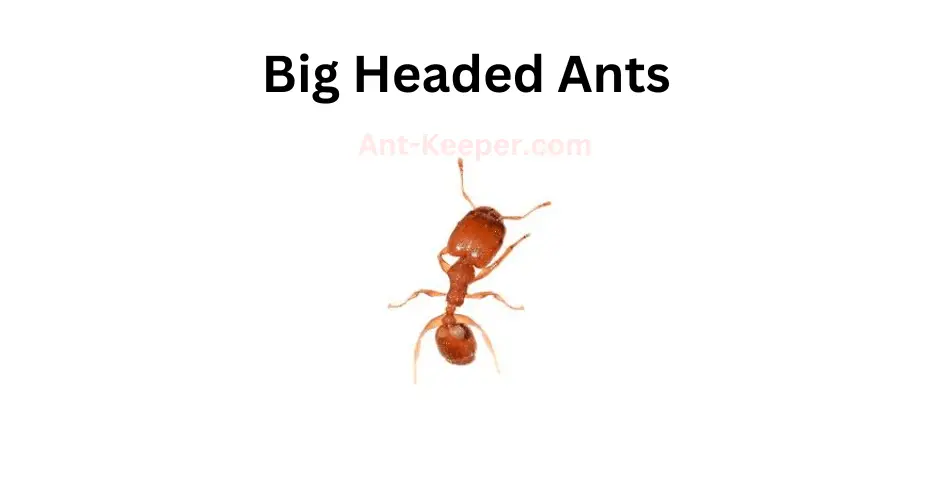
Big Headed Ants, also known as Pheidole megacephala, are a species of ant that belong to the family Formicidae.
These ants are known for their distinctive large heads, which are used for defense and communication within their colonies.
Big Headed Ants are typically found in tropical and subtropical regions, where they build their nests in soil, leaf litter, and other organic matter.
They are omnivorous, feeding on a variety of insects, seeds, and other small organisms.
One of the most interesting aspects of Big Headed Ants is their social behavior.
They live in large colonies, with a queen ant at the center of the hierarchy.
The queen is responsible for laying eggs, while the other ants in the colony perform various tasks such as foraging for food, caring for the young, and defending the colony from predators.
Big Headed Ants are also known for their ability to displace other ant species in their habitats.
They are aggressive and have been known to attack and kill other ants, as well as compete with them for resources.
Despite their aggressive behavior, Big Headed Ants are not considered a major pest species.
However, their ability to displace other ant species and their potential impact on native ecosystems make them an important species to study and monitor.
31) Big Headed Ants, Pheidole Megacephala

Big Headed Ants, also known as Pheidole megacephala, are a species of ant that belong to the family Formicidae.
These ants are known for their distinctive large heads, which are used for defense and communication within their colonies.
Big Headed Ants are typically found in tropical and subtropical regions, where they build their nests in soil, leaf litter, and other organic matter.
They are omnivorous, feeding on a variety of insects, seeds, and other small organisms.
One of the most interesting aspects of Big Headed Ants is their social behavior.
They live in large colonies, with a queen ant at the center of the hierarchy.
The queen is responsible for laying eggs, while the other ants in the colony perform various tasks such as foraging for food, caring for the young, and defending the colony from predators.
Big Headed Ants are also known for their ability to displace other ant species in their habitats.
They are aggressive and have been known to attack and kill other ants, as well as compete with them for resources.
Despite their aggressive behavior, Big Headed Ants are not considered a major pest species.
However, their ability to displace other ant species and their potential impact on native ecosystems make them an important species to study and monitor.
32) Big Headed Ants, Pheidole Teneriffana

Big Headed Ants, also known as Pheidole megacephala, are a species of ant that belong to the family Formicidae.
These ants are known for their distinctive large heads, which are used for defense and communication within their colonies.
Big Headed Ants are typically found in tropical and subtropical regions, where they build their nests in soil, leaf litter, and other organic matter.
They are omnivorous, feeding on a variety of insects, seeds, and other small organisms.
One of the most interesting aspects of Big Headed Ants is their social behavior.
They live in large colonies, with a queen ant at the center of the hierarchy.
The queen is responsible for laying eggs, while the other ants in the colony perform various tasks such as foraging for food, caring for the young, and defending the colony from predators.
Big Headed Ants are also known for their ability to displace other ant species in their habitats.
They are aggressive and have been known to attack and kill other ants, as well as compete with them for resources.
Despite their aggressive behavior, Big Headed Ants are not considered a major pest species.
However, their ability to displace other ant species and their potential impact on native ecosystems make them an important species to study and monitor.
33) Common Silvery Hunter Ants, Platythyrea Punctata
The Common Silvery Hunter Ants, also known as Dolichoderus sp., are a species of ants that belong to the family Formicidae.
These ants are commonly found in various habitats such as forests, grasslands, and urban areas.
They are known for their silvery appearance, which is due to the fine hairs covering their bodies.
The Common Silvery Hunter Ants are relatively large, with workers measuring between 5 to 8 millimeters in length.
They have a distinct head and thorax, with a narrow waist and long legs.
These ants are known for their aggressive behavior and are often seen hunting for prey, which includes other insects and small arthropods.
The colony of Common Silvery Hunter Ants is usually small, with only a few hundred individuals.
The queen ant is responsible for laying eggs, and the workers are responsible for caring for the young and maintaining the nest.
These ants are known for their ability to adapt to different environments, and they can quickly establish new colonies in areas where they have not been previously found.
The Common Silvery Hunter Ants play an essential role in their ecosystem.
They help to control the population of other insects and arthropods, which can have a significant impact on the environment.
These ants also help to aerate the soil, which is essential for plant growth.
In conclusion, the Common Silvery Hunter Ants are a fascinating species of ants that are known for their silvery appearance and aggressive behavior.
They play an essential role in their ecosystem and are an important part of the food chain.
34) Dracula Ants, Prionopelta Antillana
The Dracula Ant, also known as Mystrium camillae, is a species of ant that belongs to the subfamily Amblyoponinae.
These ants are known for their unique feeding behavior, which involves drinking the blood of their own larvae.
Dracula Ants are small in size, measuring only a few millimeters in length.
They have elongated mandibles that are used to puncture the skin of their larvae and suck out their hemolymph, a fluid similar to blood.
This behavior is known as "nondestructive cannibalism" and is thought to provide the ants with essential nutrients that are not available in their diet.
These ants are found in tropical and subtropical regions and are typically found in forested areas.
They are known for their aggressive behavior and are capable of inflicting painful bites on humans.
Dracula Ants are social insects and live in colonies that are typically composed of a queen, workers, and larvae.
The queen is responsible for laying eggs, while the workers are responsible for caring for the larvae and foraging for food.
Overall, the Dracula Ant is a fascinating species of ant that exhibits unique feeding behavior and is an important part of many ecosystems.
35) Pan-Tropical Panther Ants, Pseudoponera Stigma
The Pan-Tropical Panther Ants, also known as Paraponera clavata, are a species of large, solitary ants found throughout tropical regions around the world.
These ants are known for their painful sting, which has been described as one of the most intense insect stings experienced by humans.
Pan-Tropical Panther Ants are typically found in forested areas, where they build their nests in trees or on the ground.
They are known for their large size, with workers measuring up to 2.5 cm in length.
These ants are also distinctive for their dark brown or black coloration and their long, curved mandibles.
Pan-Tropical Panther Ants are omnivorous, feeding on a variety of insects, fruits, and nectar.
They are also known to hunt larger prey, such as spiders and caterpillars.
These ants are solitary hunters, with each individual foraging and hunting on its own.
One of the most notable features of Pan-Tropical Panther Ants is their painful sting.
The venom of these ants contains a potent toxin called poneratoxin, which causes intense pain, swelling, and redness at the site of the sting.
In some cases, the sting can also cause nausea, vomiting, and fever.
Despite their painful sting, Pan-Tropical Panther Ants are not considered a significant threat to humans.
These ants are generally non-aggressive and will only sting if provoked or threatened.
However, their painful sting has earned them a reputation as one of the most fearsome insects in the tropical regions where they are found.
36) Rogeria Foreli
Rogeria Forelibe is a species of ant that belongs to the Formicidae family.
It is a relatively small ant, with workers measuring between 2.5 and 3.5 millimeters in length.
The ant has a dark brown or blackish coloration, with a shiny exoskeleton that is covered in fine hairs.
Rogeria Forelibe ants are known for their aggressive behavior, particularly towards other ant species.
They are also known to be highly territorial, and will defend their nests vigorously against intruders.
The ants are omnivorous, feeding on a variety of food sources including insects, nectar, and plant sap.
The reproductive system of Rogeria Forelibe ants is unique, with the queen ant producing both male and female offspring.
The queen ant is also capable of reproducing asexually, producing clones of herself without the need for fertilization.
Rogeria Forelibe ants are found in a variety of habitats, including forests, grasslands, and deserts.
They are known to form large colonies, with thousands of individuals living together in a single nest.
The ants are also known to engage in symbiotic relationships with other organisms, such as aphids, which they protect in exchange for a source of honeydew.
Overall, Rogeria Forelibe ants are fascinating creatures that play an important role in their ecosystems.
Their aggressive behavior and territorial nature make them a formidable force in the ant world, while their unique reproductive system and symbiotic relationships make them a subject of interest for scientists and researchers.
37) Tropical Fire Ants, Solenopsis Geminata
The Tropical Fire Ant (Solenopsis geminata) is a species of ant that belongs to the family Formicidae.
These ants are known for their aggressive behavior and painful sting, which can cause severe allergic reactions in some individuals.
Tropical Fire Ants are typically reddish-brown in color and range in size from 2 to 6 millimeters in length.
They are commonly found in tropical and subtropical regions, where they build large nests in soil or under rocks.
These ants are omnivorous and feed on a variety of food sources, including insects, seeds, and nectar.
They are also known to tend to aphids and other insects for their honeydew excretions.
Tropical Fire Ants are highly territorial and will aggressively defend their nests against intruders.
They use their powerful mandibles to bite and their stingers to inject venom into their prey or attackers.
The venom of Tropical Fire Ants contains a mixture of alkaloids and proteins that can cause pain, swelling, and itching in humans.
In some cases, the venom can also cause anaphylaxis, a severe allergic reaction that can be life-threatening.
Despite their aggressive behavior and painful sting, Tropical Fire Ants play an important role in their ecosystem.
They help control the populations of other insects and contribute to soil health through their nest-building activities.
38) Fire Ants, Solenopsis Globularia
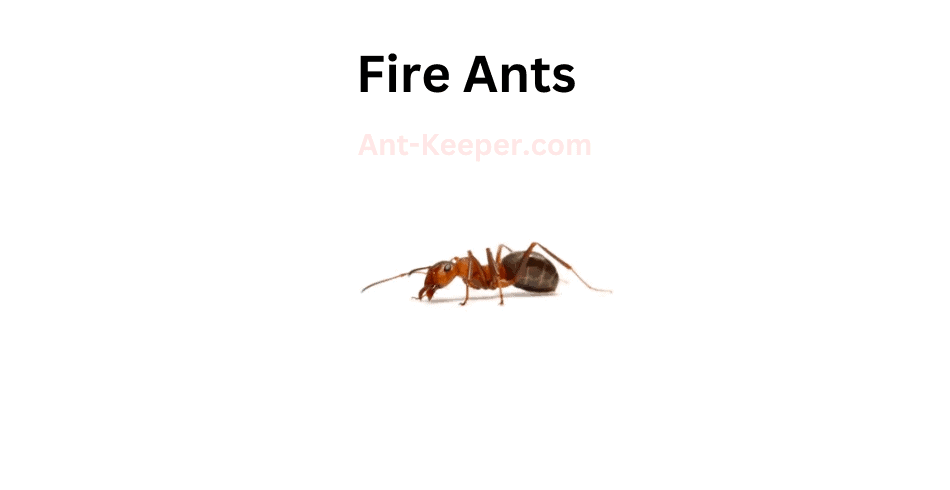
Fire ants are a type of ant that belongs to the Solenopsis genus.
They are known for their reddish-brown color and their aggressive behavior.
Fire ants are social insects that live in colonies, which can range in size from a few hundred to several thousand individuals.
Fire ants are omnivorous and feed on a variety of foods, including insects, seeds, and other small animals.
They are also known to scavenge for food and will often invade other ant colonies to steal their resources.
One of the most distinctive features of fire ants is their ability to sting.
They have a stinger located at the end of their abdomen, which they use to inject venom into their prey or enemies.
Fire ant stings can be painful and can cause an allergic reaction in some people.
Fire ants are also known for their ability to build large mounds, which can reach heights of up to 18 inches.
These mounds are made of soil and are used as a nesting site for the colony.
Fire ants are considered to be an invasive species in many parts of the world, as they can cause damage to crops and wildlife.
They are also a nuisance to humans, as their stings can be painful and their mounds can be unsightly.
Overall, fire ants are fascinating insects that have adapted to thrive in a variety of environments.
While they can be a nuisance, they are an important part of the ecosystem and play a vital role in controlling insect populations.
39) Fire Ants, Solenopsis Subterranea

Fire ants are a type of ant that belongs to the Solenopsis genus.
They are known for their reddish-brown color and their aggressive behavior.
Fire ants are social insects that live in colonies, which can range in size from a few hundred to several thousand individuals.
Fire ants are omnivorous and feed on a variety of foods, including insects, seeds, and other small animals.
They are also known to scavenge for food and will often invade other ant colonies to steal their resources.
One of the most distinctive features of fire ants is their ability to sting.
They have a stinger located at the end of their abdomen, which they use to inject venom into their prey or enemies.
Fire ant stings can be painful and can cause an allergic reaction in some people.
Fire ants are also known for their ability to build large mounds, which can reach heights of up to 18 inches.
These mounds are made of soil and are used as a nesting site for the colony.
Fire ants are considered to be an invasive species in many parts of the world, as they can cause damage to crops and wildlife.
They are also a nuisance to humans, as their stings can be painful and their mounds can be unsightly.
Overall, fire ants are fascinating insects that have adapted to thrive in a variety of environments.
While they can be a nuisance, they are an important part of the ecosystem and play a vital role in controlling insect populations.
40) Miniature Trap-Jaw Ants, Strumigenys Eggersi

The Miniature Trap-Jaw Ants, scientifically known as Odontomachus sp., are a species of ants that belong to the family Formicidae.
These ants are known for their unique and powerful mandibles, which they use to capture prey and defend their colonies.
The Miniature Trap-Jaw Ants are relatively small in size, measuring only a few millimeters in length.
They have a dark brown or black coloration and a slender body shape.
Their most distinctive feature is their mandibles, which are elongated and can snap shut with incredible force.
These mandibles are used to capture prey, crush seeds, and defend the colony against predators.
The Miniature Trap-Jaw Ants are found in a variety of habitats, including forests, grasslands, and deserts.
They are known to be active during the day and are often seen foraging for food.
These ants are omnivorous and feed on a variety of food sources, including insects, nectar, and seeds.
The Miniature Trap-Jaw Ants are social insects and live in colonies that can range in size from a few dozen to several thousand individuals.
The colony is typically led by a queen, who is responsible for laying eggs and maintaining the colony's population.
The workers are responsible for foraging, caring for the young, and defending the colony.
Overall, the Miniature Trap-Jaw Ants are fascinating insects that have evolved unique adaptations to survive in their environment.
Their powerful mandibles and social behavior make them an important part of many ecosystems.
41) Miniature Trap-Jaw Ants, Strumigenys Emmae

The Miniature Trap-Jaw Ants, scientifically known as Odontomachus sp., are a species of ants that belong to the family Formicidae.
These ants are known for their unique and powerful mandibles, which they use to capture prey and defend their colonies.
The Miniature Trap-Jaw Ants are relatively small in size, measuring only a few millimeters in length.
They have a dark brown or black coloration and a slender body shape.
Their most distinctive feature is their mandibles, which are elongated and can snap shut with incredible force.
These mandibles are used to capture prey, crush seeds, and defend the colony against predators.
The Miniature Trap-Jaw Ants are found in a variety of habitats, including forests, grasslands, and deserts.
They are known to be active during the day and are often seen foraging for food.
These ants are omnivorous and feed on a variety of food sources, including insects, nectar, and seeds.
The Miniature Trap-Jaw Ants are social insects and live in colonies that can range in size from a few dozen to several thousand individuals.
The colony is typically led by a queen, who is responsible for laying eggs and maintaining the colony's population.
The workers are responsible for foraging, caring for the young, and defending the colony.
Overall, the Miniature Trap-Jaw Ants are fascinating insects that have evolved unique adaptations to survive in their environment.
Their powerful mandibles and social behavior make them an important part of many ecosystems.
42) Miniature Trap-Jaw Ants, Strumigenys Louisianae

The Miniature Trap-Jaw Ants, scientifically known as Odontomachus sp., are a species of ants that belong to the family Formicidae.
These ants are known for their unique and powerful mandibles, which they use to capture prey and defend their colonies.
The Miniature Trap-Jaw Ants are relatively small in size, measuring only a few millimeters in length.
They have a dark brown or black coloration and a slender body shape.
Their most distinctive feature is their mandibles, which are elongated and can snap shut with incredible force.
These mandibles are used to capture prey, crush seeds, and defend the colony against predators.
The Miniature Trap-Jaw Ants are found in a variety of habitats, including forests, grasslands, and deserts.
They are known to be active during the day and are often seen foraging for food.
These ants are omnivorous and feed on a variety of food sources, including insects, nectar, and seeds.
The Miniature Trap-Jaw Ants are social insects and live in colonies that can range in size from a few dozen to several thousand individuals.
The colony is typically led by a queen, who is responsible for laying eggs and maintaining the colony's population.
The workers are responsible for foraging, caring for the young, and defending the colony.
Overall, the Miniature Trap-Jaw Ants are fascinating insects that have evolved unique adaptations to survive in their environment.
Their powerful mandibles and social behavior make them an important part of many ecosystems.
43) Miniature Trap-Jaw Ants, Strumigenys Margaritae

The Miniature Trap-Jaw Ants, scientifically known as Odontomachus sp., are a species of ants that belong to the family Formicidae.
These ants are known for their unique and powerful mandibles, which they use to capture prey and defend their colonies.
The Miniature Trap-Jaw Ants are relatively small in size, measuring only a few millimeters in length.
They have a dark brown or black coloration and a slender body shape.
Their most distinctive feature is their mandibles, which are elongated and can snap shut with incredible force.
These mandibles are used to capture prey, crush seeds, and defend the colony against predators.
The Miniature Trap-Jaw Ants are found in a variety of habitats, including forests, grasslands, and deserts.
They are known to be active during the day and are often seen foraging for food.
These ants are omnivorous and feed on a variety of food sources, including insects, nectar, and seeds.
The Miniature Trap-Jaw Ants are social insects and live in colonies that can range in size from a few dozen to several thousand individuals.
The colony is typically led by a queen, who is responsible for laying eggs and maintaining the colony's population.
The workers are responsible for foraging, caring for the young, and defending the colony.
Overall, the Miniature Trap-Jaw Ants are fascinating insects that have evolved unique adaptations to survive in their environment.
Their powerful mandibles and social behavior make them an important part of many ecosystems.
44) Rogers Dacetine Ants, Strumigenys Rogeri
Roger's Dacetine Ants are a species of ant that belong to the Dacetini tribe.
They are known for their small size, measuring only a few millimeters in length.
These ants are typically found in forested areas and are known to be arboreal, meaning they live in trees.
One of the unique characteristics of Roger's Dacetine Ants is their ability to form colonies with multiple queens.
This is a rare trait among ants, as most species have only one queen per colony.
The queens of this species are also known to be relatively small in size compared to other ant species.
Roger's Dacetine Ants are omnivorous, meaning they consume both plant and animal matter.
They are known to feed on small insects, nectar, and honeydew produced by aphids.
These ants are also known to have a mutualistic relationship with certain species of plants, where they protect the plant from herbivores in exchange for food.
Despite their small size, Roger's Dacetine Ants play an important role in their ecosystem.
They help to control populations of small insects and contribute to the pollination of certain plant species.
However, like many other ant species, they are also susceptible to habitat loss and other threats to their survival.
45) Groove-Headed Fierce Ants, Tetramorium Simillimum
Groove-Headed Fierce Ants, also known as GFA, are a species of ants that belong to the Formicidae family.
They are known for their aggressive behavior and their ability to defend their colonies fiercely.
The name "groove-headed" comes from the distinct groove on their head that separates their eyes from their antennae.
GFAs are relatively small, measuring only about 3-5 millimeters in length.
They have a dark brown or black coloration and a slender body shape.
Their mandibles are long and sharp, which they use to capture prey and defend their colony.
These ants are social insects and live in large colonies that can contain up to several thousand individuals.
The colony is usually led by a queen ant, who is responsible for laying eggs and maintaining the colony's population.
The workers, which are sterile females, are responsible for foraging for food, caring for the young, and defending the colony.
GFAs are omnivorous and feed on a variety of food sources, including insects, nectar, and honeydew.
They are also known to scavenge for dead animals and consume plant material.
One of the most notable characteristics of GFAs is their aggressive behavior.
They are known to attack and kill other insects, including other ant species.
When threatened, they will swarm and bite their attacker, injecting formic acid into their wound.
This acid can cause pain and irritation to the attacker, and in some cases, can even be lethal.
Overall, GFAs are a fascinating species of ants that exhibit unique behaviors and characteristics.
Their fierce nature and ability to defend their colony make them an important part of their ecosystem.
46) Singapore Ants, Trichomyrmex Destructor
The Singapore ant, also known as the Asian needle ant, is a species of ant that belongs to the Formicidae family.
These ants are known for their aggressive behavior and are considered to be a nuisance pest in many areas.
They are typically found in urban and suburban environments, where they can be seen foraging for food and building their nests.
The Singapore ant is a small ant, measuring only a few millimeters in length.
They are typically black or dark brown in color, with a slender body and long legs.
These ants are known for their sharp stingers, which they use to defend themselves and their colony.
The Singapore ant is a social insect, living in large colonies that can contain thousands of individuals.
They are organized into a caste system, with workers, soldiers, and a queen.
The workers are responsible for foraging for food, caring for the young, and maintaining the nest.
The soldiers are larger and more aggressive, and are responsible for defending the colony from predators.
These ants are omnivorous, feeding on a variety of foods including insects, fruits, and sweet substances.
They are known for their ability to adapt to different environments, and can be found in a variety of habitats including forests, grasslands, and urban areas.
Despite their small size, the Singapore ant can be a significant pest in urban areas.
They are known for their aggressive behavior and can sting humans and pets if provoked.
They can also damage crops and invade homes in search of food.
Overall, the Singapore ant is a fascinating species of ant that is well adapted to urban environments.
While they can be a nuisance pest, they play an important role in the ecosystem and are an important part of the food chain.
47) Little Fire Ants, Wasmannia Auropunctata
The Little Fire Ant (Wasmannia auropunctata) is a small, reddish-brown ant species that measures only 1.5 to 3 mm in length.
They are known for their painful sting, which can cause a burning sensation and small blisters on the skin.
Little Fire Ants are native to South and Central America, but have been introduced to other parts of the world through human activity.
They are considered invasive species and have caused significant ecological and economic damage in some areas.
These ants are highly adaptable and can thrive in a variety of habitats, including forests, grasslands, and urban areas.
They are omnivorous and feed on a wide range of food sources, including insects, fruits, and seeds.
Little Fire Ants are social insects that live in colonies with a queen and workers.
They reproduce quickly and can form large colonies with thousands of individuals.
They are known for their aggressive behavior towards other ant species and can outcompete them for resources.
Controlling Little Fire Ant populations can be challenging due to their small size and ability to nest in hard-to-reach areas.
Integrated pest management strategies, such as baiting and chemical treatments, are often used to manage infestations.
Overall, the Little Fire Ant is a fascinating but problematic species that highlights the importance of preventing the introduction of invasive species to new environments.
Check Out Some Of Our Other Ants By Location Posts
| Types Of Ants In Hokkaido, Japan | Hokkaido, the northernmost island of Japan, is a region known for its stunning natural beauty and unique wildlife. With a climate that is cooler and ... |
| Types Of Ants In Botswana | Botswana, a landlocked country located in Southern Africa, is known for its diverse wildlife and vast landscapes. The country is home to a variety of ... |
| Types Of Ants In Norfolk Island | Norfolk Island is a small island located in the Pacific Ocean, east of Australia. The island is known for its unique environment, which is home ... |
| Types Of Ants In New South Wales, Australia | New South Wales, located in the southeastern region of Australia, is a diverse and vibrant state known for its stunning natural beauty and unique wildlife. ... |
| Types Of Ants In Ireland | Ireland, located in the northwestern region of Europe, is a country known for its lush green landscapes and diverse wildlife. The country is surrounded by ... |
